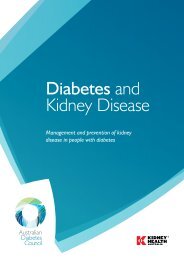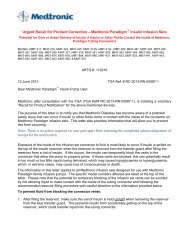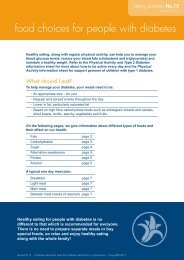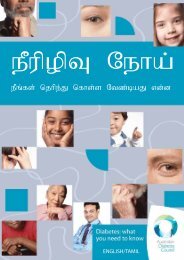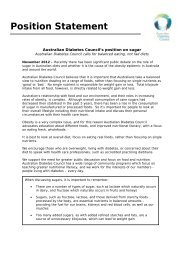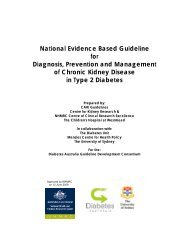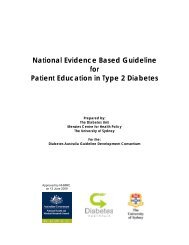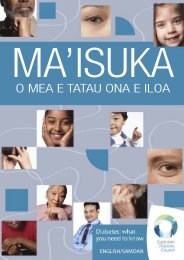Part 6: Detection and Prevention of Foot Problems in Type 2 Diabetes
Part 6: Detection and Prevention of Foot Problems in Type 2 Diabetes
Part 6: Detection and Prevention of Foot Problems in Type 2 Diabetes
You also want an ePaper? Increase the reach of your titles
YUMPU automatically turns print PDFs into web optimized ePapers that Google loves.
Background - Peripheral Vascular Disease as a Risk FactorPeripheral vascular disease (PVD) is common <strong>in</strong> people with <strong>Type</strong> 2 diabetes be<strong>in</strong>gpresent <strong>in</strong> 8% at the time <strong>of</strong> diagnosis <strong>and</strong> <strong>in</strong> 45% <strong>of</strong> people who have had diabetes for20 years (Hiatt & Sussman, 1994). The prevalence <strong>of</strong> PVD at diagnosis <strong>of</strong> diabetes<strong>and</strong> the risk <strong>of</strong> develop<strong>in</strong>g PVD over time <strong>in</strong>crease with <strong>in</strong>creas<strong>in</strong>g age (Davis et al,1997).PVD is considered to be the most important factor related to outcome <strong>of</strong> a diabeticfoot ulcer (International Work<strong>in</strong>g Group on the Diabetic <strong>Foot</strong>, 1999) <strong>and</strong> is a majorcontributor to the high rates <strong>of</strong> amputation <strong>in</strong> people with diabetes as well aspredict<strong>in</strong>g <strong>in</strong>creased risk <strong>of</strong> cardiovascular mortality (Orchard & Str<strong>and</strong>ness, 1993).Vascular assessment <strong>in</strong> the general practice sett<strong>in</strong>g is, by necessity, based on history<strong>and</strong> cl<strong>in</strong>ical exam<strong>in</strong>ation. More sophisticated bedside <strong>in</strong>vestigations are available <strong>and</strong>have been shown to predict ulceration <strong>and</strong> amputation. The ankle-arm <strong>in</strong>dex (AAI) orankle-brachial <strong>in</strong>dex (ABI), is a ratio <strong>of</strong> blood pressure measured <strong>in</strong> the arm <strong>and</strong> <strong>in</strong> theankle by a h<strong>and</strong>-held ultrasound doppler. A ratio <strong>of</strong> less than 0.50 <strong>in</strong>dicates severePVD. Calcification <strong>of</strong> pedal arteries, which is common <strong>in</strong> people with diabetes, results<strong>in</strong> a falsely high blood pressure read<strong>in</strong>g <strong>in</strong> the feet <strong>and</strong> consequently a falsely highratio. In addition, the repeatability <strong>of</strong> the AAI/ABI measure has a coefficient <strong>of</strong>variation <strong>of</strong> 10 to 15% <strong>and</strong> therefore requires duplicate read<strong>in</strong>gs. In view <strong>of</strong> theequipment <strong>and</strong> time required to perform the exam<strong>in</strong>ation, AAI/ABI may be used <strong>in</strong> aspecialist practice but has limited application <strong>in</strong> a busy general practice.Transcutaneous oximetry (TcPO 2 ) is a measurement <strong>of</strong> partial pressure <strong>of</strong> oxygen atthe sk<strong>in</strong> surface. Levels less that 50mmHg are associated with PVD <strong>and</strong> a reducedheal<strong>in</strong>g ability (McNeely et al, 1995).Invasive techniques such as angiography are more specific <strong>in</strong> demonstrat<strong>in</strong>g PVD butare also associated with significant morbidity. In a study <strong>of</strong> 104 people with diabetes,both a score based on the results <strong>of</strong> an angiogram (OR 2.32 [CI 1.40-3.84]) <strong>and</strong> theABI (OR 1.84 [CI 1.10-3.06]) were predictive <strong>of</strong> major amputation (Faglia et al,1998).Evidence - Peripheral Vascular Disease as a Risk FactorPeripheral vascular disease is a risk factor for amputationIn the prospective Seattle Diabetic <strong>Foot</strong> Study <strong>of</strong> 776 veterans with diabetes, PVD hasbeen shown to be an <strong>in</strong>dependent risk factor for amputation (RR 3.0, CI 1.3-7.1)(Adler et al, 1999). In a multivariate model relative to a reference hazard ratio (HR) <strong>of</strong>1 for an <strong>in</strong>dividual with neither PVD (as <strong>in</strong>dicated by absent or dim<strong>in</strong>ished pulses) norneuropathy, <strong>in</strong>dividuals with PVD <strong>in</strong> either leg but without neuropathy had an HR foramputation <strong>of</strong> 20.5 compared with an HR <strong>of</strong> 9.3 for neuropathy alone <strong>and</strong> HR 19.0when both PVD <strong>and</strong> neuropathy were present. When different measures <strong>of</strong> PVD wereused <strong>in</strong> a multivariate hazards model, AAI ≤0.8 <strong>in</strong> either lower extremity, TcPO 2 ≤50mmHg <strong>in</strong> either foot <strong>and</strong> absence/dim<strong>in</strong>ished peripheral pulses gave a similar HR for21




